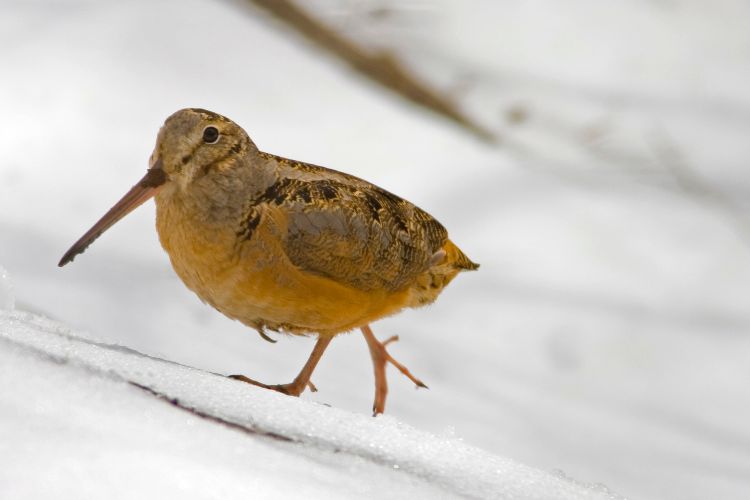
Published December 9, 2020
Let’s Go Birding | Brrr...Bird Behavior in Winter
By Laura Carberry
As the colder weather approaches, many birds shift their behaviors and even food sources to survive the winter. While many migrate south, several species have developed amazing adaptations to survive the winter months.
A bird’s body temperature is approximately 105 degrees Fahrenheit, so it takes them a lot of energy to keep warm in cold weather. Although some birds may look fatter in winter, it isn’t from gaining a few ounces. They fluff up their feathers to trap the warm air from their bodies. It’s like putting on a warm downy coat. But at night, when it really gets cold, some birds have learned to drop their body temperature and huddle together to conserve energy. Scientists have found that Golden-crowned Kinglets will roost together with 4 or more of their friends to survive the cold winter nights. Other birds like Black-capped Chickadees and Eastern Bluebirds will find cavities or nest boxes to huddle together at night. If you have nest boxes, now is the time to clean them out so birds have room to roost together. And check them periodically to ensure that mice haven’t moved in, as they love to overwinter in these boxes as well. Consider purchasing or building a nest box or roosting box if you don’t have natural nesting cavities in your yard.
Because birds have such a high body temperature, they also have a high metabolism. They need to be constantly refueling with high protein energy sources. If you are walking through the woods in winter, you might come across a noisy flock of Chickadees, Tufted Titmice, and Kinglets. These mixed flocks of birds are actually helping each other. They comb the area for insects, berries and seeds. If they notice their neighbor has found food, they will all head in that direction. That is why when your bird feeder first goes up in winter, you may quickly see a flock of birds all at once. They watch each other and communicate where the food sources are. This is a great adaptation when resources are scarce.
Good quality food is always helpful for birds in winter. Suet is a high protein food that you can provide for Woodpeckers, Nuthatches, Pine Warblers, Chickadees and Tufted Titmice. Raw beef suet from the supermarket can easily become rancid, so a better alternative is rendered blocks of suet or suet cakes. These are easily slipped into a cage feeder without the mess. Some of these cakes have peanuts, seeds, insect or berries added - all which the birds love.
A sure way to attract Bluebirds is to offer mealworms. They provide an excellent source of nutrients. You can find Bluebird feeders for sale, provide dried mealworms, or if you are bold, offer live ones! Live mealworms can be costly, so I suggest putting out just a few a day and offering suet cakes or berries as well.
Tube feeders that hold sunflower, safflower, cracked corn and millet are popular because of the diversity of the seeds they can hold and many birds are able to use them. If you love finches make sure you have a thistle feeder with very small holes that offer birds the tiny Nyger seeds.
And don’t forget your ground feeders like doves, sparrows and cardinals. These birds don’t do well on perches and need a little extra space to land. Keep those birds safe from cats and other predators by using a platform feeder. Just offer millet and cracked corn to encourage them to visit.
Birds also need an open source of water in winter. Look for a heated bird bath that you know will not freeze. And remember to clean both your bird baths and feeders regularly! Happy feeding!
The Audubon Gift Shop in Bristol is a great resource for all your bird feeding needs. They are happy to answer questions and help you make the right selections. Please stop in the Nature Center and Aquarium or shop online by visiting asri.org/natureshop.




















